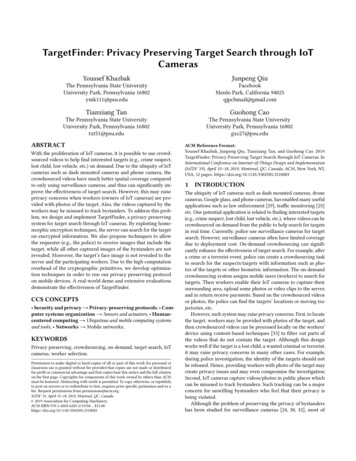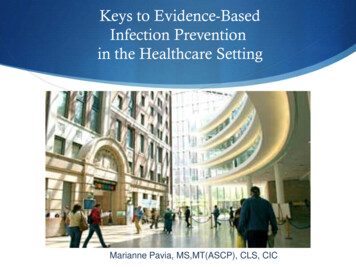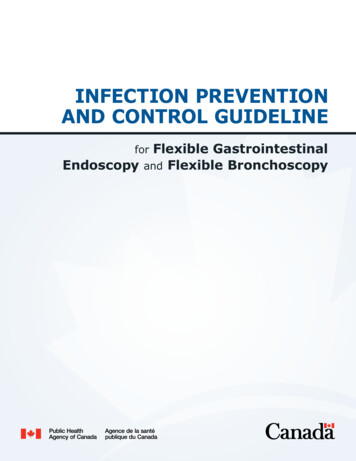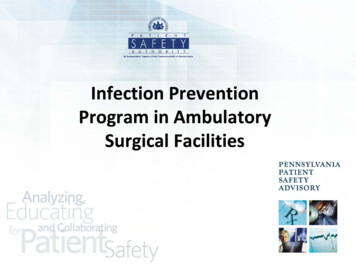
Transcription
Infection PreventionProgram in AmbulatorySurgical Facilities
Patient Safety in the Ambulatory Surgical Setting2
History and Background of Centers for Medicare andMedicaid Services (CMS) Regulations January 2008—cluster of patients with acute hepatitis Cinfection identified by Southern Nevada Health District. 63,000 possible patient exposures between March 2004 andJanuary 2008—all preventable. All patients had undergone procedures at the Endoscopy Centerof Southern Nevada. Unsafe injection practices identified that placed patients at riskfor bloodborne pathogens. Reuse of syringes to access vials of propofol could haveintroduced the blood of infected patients, and the multidosevials were reused for subsequent patients.3
Where Are We Today?What are we learning from ongoing state inspections?Overall, ambulatory surgical facilities (ASFs) across the nation aretaking the regulations seriously and making an effort to improvepractices.However, recent studies have revealed that practices are still notwhere they need to be. In New Jersey, 49 of 91 surgical facilitiesstudied did not meet federal Medicare standards. More than aquarter of the centers studied were cited for violations that putthem in "immediate jeopardy," meaning patients were in danger ofserious injury, harm, or death.In a recent report by the Illinois Department of Public Health, twothirds of the ASFs were cited for lack of best practices.4
Where Are We Today?What are we learning from ongoing state inspections? Failure to label open bottles of solution and medication vialsappropriately Failure to provide medical staff with educational opportunities Lack of clarification surrounding staff designated to head theinfection prevention program Lack of follow-up with possible surgical site infections (SSIs) Contamination of the sterile field with used or dirty instruments Inadequate sterilization times Failure to ensure proper testing of sterilizers5
Where Are We Today?What are we learning from independent on-site visits? Cleaning of equipment (particularly high-touch surfaces) betweenpatients is inconsistent and, at times, nonexistent. Due to rapid turnover of patients, endoscopy centers areshortcutting cleaning between patients. Endoscopy centers are reusing gowns. Instrument and scope reprocessing failures are present. Reprocessing room is used for cleaning dirty instruments andstoring sterile packs.6
Where Are We Today?What are we learning from independent on-site visits? Active surveillance systems are inconsistent or nonexistent. There is a lack of communication and feedback with staff members. Immediate-use sterilization (formerly known as “flashing” or flashsterilization) takes place due to lack of instrument trays in busycenters. Blood glucose meters are inadequately cleaned between patients. Disposable gowns are reused in the operating room (OR) suites.7
Infection Prevention Risk AssessmentRisk Assessment (tool provided) Used to develop and review your overall infection preventionprogram Used to evaluate potential risk for infection, contamination, andexposure 8Used to assist you with surveillance efforts—process and outcomesBased on the community you serveBased on the services you provideEach center’s priorities will be different
Leadership and Committee Responsibilities Implement and/or maintain a facility-wide infection preventionprogram that follows nationally recognized guidelines. Develop clearly written policies and procedures. Designate a clinical staff member qualified to manage the program. Provide the designated person with training opportunities. Allot time for the trained person to perform infection preventionfunctions (depends on risk assessment). Background and training of medical staff should be obtained fromcredentialing records.9
Leadership and Committee Responsibilities Infection prevention should be included in the annual nursingcompetencies. Surveillance, tracking, and documentation of infections withappropriate facility feedback should be implemented. Form an infection control committee and stipulate members(department listing versus personnel names); include a communitymember as per Act 52 of 2007. Regular meetings determined by the facility should be conducted(can be incorporated into quality assessment and performanceimprovement [QAPI] meetings). All infection control activities, findings, surveillance data, andincidents should be reported at each meeting.10
Education Pertains to all staff members, including medical personnel andoutside contractual companies (e.g., pharmacy, housekeeping). All new personnel will attend an orientation program thataddresses general infection control principles and practices. Orientation will also include education related to hand hygiene,isolation, Occupational Safety and Health Administrationbloodborne pathogens regulations, tuberculosis exposure controlplans, multidrug-resistant organisms (MDROs), influenza vaccine,and more. All personnel will attend at least one mandatory infection controlupdate per year (e.g., reorientation), which will include any updatesin general infection prevention (e.g., MDRO updates, newinformation pertaining to ASF infection prevention).11
Education Educational programs, excluding orientation, can be in theform of online training, webinars, and audio conferences. Educational programs should be documented, and nursesshould receive credit during annual competencies. Individual records should be maintained, which documentthe following: Date and time of training Instructor and qualifications Content outline12
Standard Precautions Apply to all patients, as all blood, body fluids, excretions, andsecretions (except sweat) are considered potentiallyinfectious Designed to reduce the risk of transmission ofmicroorganisms from both recognized and unrecognizedsources of infection Used in conjunction with transmission-based precautions ifindicated13
Standard PrecautionsComponents include: 14Hand hygiene (addressed in CMS audit tool module)Gloves (addressed in CMS audit tool module)GownsMaskingEyewear (goggles)Environmental cleaningPractices for special lumbar puncture proceduresSafe injection practices (addressed in CMS audit tool module)Blood glucose monitoring devices (addressed in CMS audit toolmodule)
Transmission-Based PrecautionsDue to the transient nature of the patient’s stay atan ASF, as well as the patient population (in mostinstances, a healthy, ASA class III or below), thefacility’s use of transmission-based isolationprecautions is a rare occurrence.Upon initial assessment, if a patient is identified tohave a condition or disease that requirestransmission-based precautions, the procedure willbe rescheduled if possible; however, that may not befeasible, and each case must be separately assessed.15
Contact Isolation Direct-contact transmission involves directbody-surface-to-body-surface contact andphysical transfer of microorganisms, oftenvia contaminated hands that are not washed. Indirect-contact transmission involvescontact of a susceptible host with acontaminated intermediate object (fomite),usually inanimate, such as contaminatedinstruments, needles or dressings, or glovesthat are not changed between patient care.
Contact Isolation Private room at all times, as per CDCguidelines—patient to be kept out of commonareas, including the waiting room. Limit the movement and transport of patients. Dedicate the use of noncritical patient careequipment and items in areas (e.g.,stethoscopes, blood pressure cuffs, electronicthermometers).17
Droplet PrecautionsDroplet precautions are intended to preventtransmission of pathogens spread through closerespiratory or mucous membrane contact withrespiratory secretions. Because these pathogensdo not remain infectious over long distances in ahealthcare facility, special air handling andventilation are not required to prevent droplettransmission.18
Droplet PrecautionsInfectious agents for which droplet precautionsare indicated include Bordetella pertussis,influenza virus, adenovirus, rhinovirus, Neisseriameningitidis, and group A streptococci (for thefirst 24 hours of antimicrobial therapy).It is preferable to reschedule surgery for patientsinfected with a pathogen that can be spread viathe droplet route.19
Droplet Precautions In the event that surgery is unavoidable, asingle-patient room is preferred for patientswho require droplet precautions. When a single-patient room is not available,spatial separation of 3 feet and drawing thecurtain between patient beds is especiallyimportant for patients in multibed rooms withinfections transmitted by the droplet route.20
Droplet Precautions Healthcare personnel should wear a mask forclose contact with infectious patients, and themask should be donned upon room entry. Patients on droplet precautions who must betransported outside the room should wear amask if tolerated and follow respiratory hygieneand cough etiquette.Note: Active tuberculosis (TB) patients require airborne precautions. Unless an ASF is equipped tohandle these patients, they should not be admitted to an outpatient setting unless the plant isin compliance with American Institute of Architects/Facility Guidelines Institute (AIA/FGI)standards for an airborne infection isolation room.21
Visitors and Ancillary Support Personnel Visitors may include those who are in the area to accompanypatients (e.g., family member, significant other, guard,interpreter). The facility is responsible for advising all visitors of theinfection prevention policies that are in place for the purposeof patient and employee safety. Observers may include radiology, medical, and nursingstudents. Professionals (e.g., visiting surgeons, residents and interns,ancillary service personnel such as radiology services andsales representatives) may request entrance to the OR suiteas part of their work.22
Visitors and Ancillary Support Personnel Other hospital employees (e.g., biomedical equipmenttechnicians, maintenance or computer support personnel)may need entrance to repair equipment.POLICY Individuals with signs and symptoms of an acute infectionsuch as upper or lower respiratory infection (e.g., cold, sorethroat, cough) should not be permitted in the center. Professionals and ancillary service personnel who enter thefacility should adhere to all policies and procedures of thefacility. This includes but is not limited to hand hygiene anduse of personal protective equipment.23
Visitors and Ancillary Support Personnel Hair covers, shoe covers, and freshly laundered clothingintended for OR use should be worn within semirestrictedand restricted areas. Brief visitors in the OR should be given a one-piece coverall aswell as hair and shoe covers, and each situation should beassessed on a case-by-case basis. If a child is having surgery, parents accompanying the child toa preoperative preparation or holding area may requirewearing cover gowns and hair/shoe covers instead of fullgarb. Delineated traffic flow/patterns and proper attire must befollowed by all visitors.24
OR Traffic Control Traffic control is to deter unauthorized individuals and equipmentfrom entering the restricted area in compliance with establishedinfection control policies and regulatory standards. Each facility should incorporate a policy relating to restricted areasand traffic flow in and out of those areas. Generally, restrictedareas include the following:– All OR suites, hallways outside of OR rooms, OR sterile supplyrooms, OR work rooms, scope cleaning rooms, scope storagerooms, equipment storage rooms, decontamination rooms, andinstrument processing rooms The preoperative and postanesthesia care areas are unrestrictedareas with regard to surgical attire (i.e., personal protectiveequipment), but traffic is restricted and to be kept to a minimum.25
Employee Health The purpose of an employee health program isto provide guidelines and standards for theprevention and control of infections occurring inthe occupational setting. All employees will follow the standardizedemployee health guidelines and standards toprevent and control the transmission ofinfections to and from employees and patients.26
Employee HealthElements of an employee health program A collaborative relationship with the infection preventionprogram Post-offer health screening Annual influenza vaccination program Annual TB screening program Management of occupational exposures Maintenance of records and confidentiality27
Additional Components Infection control risk assessment (ICRA) forconstruction Bloodborne pathogen exposure control plan—OSHA requirement TB exposure control plan—OSHA requirement28
ReferencesAssociation of periOperative Registered Nurses (AORN). Perioperativestandards and recommended practices, 2011 edition. Denver (CO):AORN Inc.; 2011.Centers for Disease Control and Prevention, Healthcare InfectionControl Practices Advisory Committee. Guide to infection preventionfor outpatient settings: minimum expectations for safe care [online].2011 May [cited 2011 Oct ds-of-ambulatorycare-7-2011.pdf.Centers for Medicare and Medicaid Services. State Operations Manual(SOM) appendix L, ambulatory surgical centers (ASC) comprehensiverevision [memorandum online]. 2009 May 15 [cited 2011 Oct /downloads/SCLetter09 37.pdf.29
ReferencesGOJO. Sample infection control risk assessment—ambulatory surgerycenters [online]. 2011 Mar [cited 2011 Oct 26].http://www.gojo.com/ %20assessment.docx.Labus B. Outbreak of hepatitis C at outpatient surgical centers: publichealth investigation report [online]. 2009 Dec [cited 2011 Oct epc-investigationreport.pdf.30
ReferencesLakeland Surgical and Diagnostic Center. Sample woundinfection/unexpected outcome report [online]. 2010 Nov 3 [cited 2011Oct rt.doc.Siegel JD, Rhinehart E, Jackson M, et al. 2007 guideline for isolationprecautions: preventing transmission of infectious agents in healthcaresettings [online]. [cited 2011 Oct. precautions.html.31
Resources29 CFR § 1910.1030 (2001). Also available athttp://www.osha.gov/pls/oshaweb/owadisp.show document?p table STANDARDS&p id 10051.42 CFR § 416.44 (2010). Also available athttp://edocket.access.gpo.gov/cfr 2010/octqtr/pdf/42cfr416.44.pdf.Centers for Medicare and Medicaid Services (CMS). Appendix L—guidance for surveyors: ambulatory surgical centers. In: CMS. Stateoperations manual 07ap l ambulatory.pdf.32
Questions and Answers33
Association of periOperative Registered Nurses (AORN). Perioperative standards and recommended practices, 2011 edition. Denver (CO): AORN Inc.; 2011. Centers for Disease Control and Prevention, Healthcare Infection Control Practices Advisory Committee. Guide to infection prevention for outpatient settings: minimum expectations for safe care .

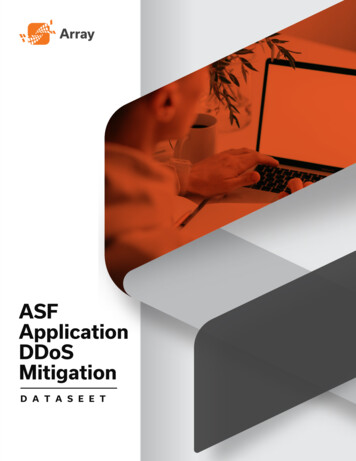
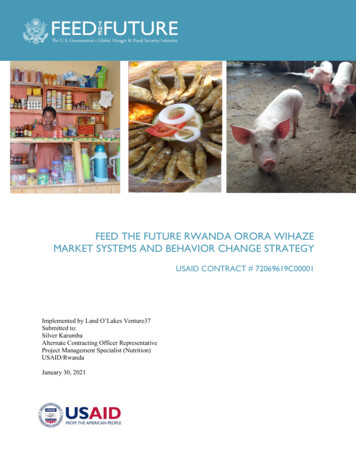
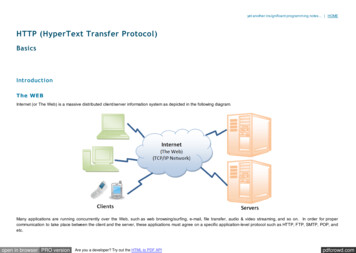

![4535&(* '3.&803, '03 %&.* 41 & ] - University of Virginia](/img/39/uvaacademicspaceframeworkplan.jpg)
